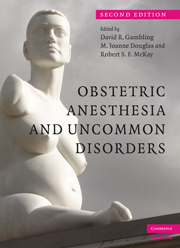Book contents
- Frontmatter
- Contents
- List of plates
- List of contributors
- Preface
- Section 1 Cardiovascular and respiratory disorders
- Section 2 Musculoskeletal disorders
- 5 Myopathies
- 6 Parturients of short stature
- 7 Disorders of the vertebral column
- 8 Miscellaneous skeletal and connective tissue disorders in pregnancy
- Section 3 Nervous system disorders
- Section 4 Metabolic disorders
- Section 5 Other disorders
- Index
- Plate Section
- References
7 - Disorders of the vertebral column
from Section 2 - Musculoskeletal disorders
Published online by Cambridge University Press: 19 October 2009
- Frontmatter
- Contents
- List of plates
- List of contributors
- Preface
- Section 1 Cardiovascular and respiratory disorders
- Section 2 Musculoskeletal disorders
- 5 Myopathies
- 6 Parturients of short stature
- 7 Disorders of the vertebral column
- 8 Miscellaneous skeletal and connective tissue disorders in pregnancy
- Section 3 Nervous system disorders
- Section 4 Metabolic disorders
- Section 5 Other disorders
- Index
- Plate Section
- References
Summary
Introduction
Symptoms relating to the musculoskeletal system are among the most common complaints registered by pregnant women. The maternal axial skeleton is subjected to considerable gestational changes and stresses and skeletal anomalies, both congenital and acquired, may impact on the process and outcome of gestation and labor. Among the most important of these anomalies is scoliosis, arising either as the idiopathic form or as a result of an underlying neuromuscular disorder.
Other syndromes are less commonly encountered: these include disc prolapse, osteoporosis of pregnancy, and spondylolysis and spondylolisthesis.
Scoliosis
Moderate to severe scoliotic curves are not common in women of childbearing age. The major reason for this is that screening programs identify many at-risk women early in the disease process, resulting in timely intervention and curve correction. Additionally, primary neuromuscular diseases that result in scoliosis are relatively rare and may themselves limit a woman's reproductive potential. Despite the fact that women with moderate to severe scoliosis constitute a small population of obstetric patients, pregnancy within this population is common. The process and outcome of pregnancy, labor, and delivery are often similar in women with scoliosis compared with the general population. However, if the disease process is advanced, pregnancy and labor may not only be complicated, but also life-threatening. In this small subpopulation, a detailed understanding of the pathophysiology of advanced scoliosis and the interaction with pregnancy is necessary to provide effective maternal care.
- Type
- Chapter
- Information
- Obstetric Anesthesia and Uncommon Disorders , pp. 129 - 144Publisher: Cambridge University PressPrint publication year: 2008
References
- 1
- Cited by



